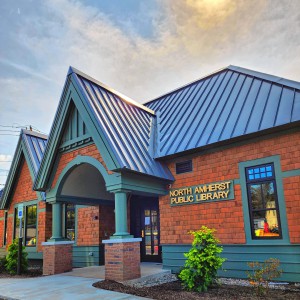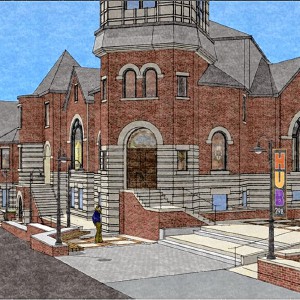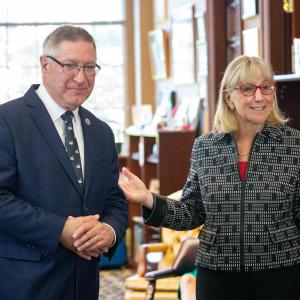Easing the shortage: New program will train 70 EMTs, paramedics in western Mass
| Published: 08-06-2023 10:08 AM |
EASTHAMPTON — A decade ago, Highland Ambulance Services covered the Hilltowns with 48 EMTs and paramedics. Today, the company employs just 27, with only three of them full-time workers.
“There’s a lot of overtime, and we’re very grateful, but that’s the scary part of this is the burnout factor for the people that are taking on extra stuff to maintain us right now,” said Michael Rock, service director at Highland.
Highland is by no means alone, both throughout the region and across the state and country. Last year, the national turnover rate for full-time emergency medical technicians, known as EMTs, was 36% and for full-time paramedics, it was 27%, according to an American Ambulance Association survey. A federal study projected a need for 40,000 more full-time emergency medical personnel from 2016 to 2030.
Hampshire County experts say the burdensome shortage is also affecting their communities. That’s why some are hopeful that a new training program being launched by the Easthampton Fire Department on behalf of several Hampshire County communities pays dividends.
Backed by a $229,000 Assistance to Firefighters Grant awarded by the Federal Emergency Management Agency (FEMA), the money will help provide training for fire departments in Easthampton, Southampton, Belchertown, South Hadley Districts 1 and 2, Ware, Hadley, and Highland Ambulance Services in the Hilltowns.
Specifically, the grant will provide training for 70 new paramedics and EMTs across the region.
“Our goal is to help increase the pool of trained personnel to provide emergency medical services in the region,” Easthampton Fire Chief Christopher Norris said.
Easthampton will serve as the “host agent,” meaning the city will take care of quarterly reporting requirements.
Article continues after...
Yesterday's Most Read Articles
 Northampton bans auto dealerships near downtown; zone change won’t affect Volvo operation on King Street
Northampton bans auto dealerships near downtown; zone change won’t affect Volvo operation on King Street
 Proposed Hatfield pickleball/tennis building raising eyebrows
Proposed Hatfield pickleball/tennis building raising eyebrows
 South Hadley man killed in I-91 crash
South Hadley man killed in I-91 crash
 ‘Home away from home’: North Amherst Library officially dedicated, as anonymous donor of $1.7M revealed
‘Home away from home’: North Amherst Library officially dedicated, as anonymous donor of $1.7M revealed
 Police respond to alcohol-fueled incidents in Amherst
Police respond to alcohol-fueled incidents in Amherst
 Public gets a look at progress on Northampton Resilience Hub
Public gets a look at progress on Northampton Resilience Hub
Obtaining the grant is a competitive process. Out of about 18,000 applicants each year, FEMA typically issues around just 2,000 grants.
The demand for trained emergency responders has increased significantly over the past decade and especially since the COVID-19 pandemic.
“Because COVID shut a lot of educational institutions down … there were no people coming through the process who are now trained,” said Norris. “So it’s a huge, sharp decline that we’re seeing in trained personnel able to respond to these emergencies.”
A 2021 letter to Congress from the American Ambulance Association stated that a survey of 20,000 EMS employees found a turnover rate of 20-30% each year for EMTs and paramedics.
“With percentages that high, ambulance services face 100% turnover over a four-year period,” read the letter. “Staffing shortages compromise our ability to respond to healthcare emergencies, especially in rural and underserved parts of the country.”
J. Dominic Singh, EMS coordinator at UMass Amherst, said the high turnover rate can be attributed to low pay, working conditions, and long hours, among other factors.
Hadley Fire Chief Mike Spanknebel said the department currently contracts Action Ambulance Service for its single in-house ambulance, but is aiming to start its own basic ambulance service.
“It’s tough to find firefighter EMTs that are either paramedics or basics,” said Spanknebel. With the grant, he said, “We’re hoping to get two of our EMT basics moving into a paramedic position … that will help us to eventually transition to a paramedic-level ambulance.”
While basic EMTs are able to provide basic pre-hospital emergency care and transportation, paramedics are more highly trained and are able to provide more advanced medical procedures such as performing tracheostomies and providing medication.
That all adds up to “higher quality care,” according to Rock. And with fewer trained paramedics and EMTs, fewer ambulances are able to respond to calls.
“What ends up happening if we aren’t able to provide an ambulance because we’re unable to staff it is that it goes to another service,” Rock said. “It’s just been burdening, and all the services in the area are feeling it because we’re all providing mutual aid to each other.”
Part of the reason it is difficult to get new paramedics and EMTs on board, according to Norris, is that training expenses are high.
On average, the cost of paramedic training is $10,000, and the cost of basic EMT training is $1,500.
“Having the ability to offset the cost of that training for these individuals is pretty significant,” Norris said, adding that the federal government does require a 10% match on cost. “For example, if the paramedic training was $10,000, the individual will be responsible to pay $1,000 of that, which is significantly less.”
Norris said the goal is to maximize the grant and train 60 basic EMTS along with 10 paramedics over the course of two years, which is how long the departments have to use up grant funding.
Not only will existing personnel have the opportunity to become certified at a paramedic or basic EMT level, but training will also function to bring new people into the field and increase the workforce in fire departments and ambulance services.
The vision is to offer two basic EMT classes at 30 people per class. The first class is expected to be held in January and February 2024, and the second class will be held the following year.
Paramedic training will likely begin this September, and since the program is longer in duration, participants will complete their training around the time the grant ends in July 2025.
“If we can get 10 people trained right here locally, in this immediate area, that will significantly help the shortage of paramedics in our services,” Norris said.
“The more people we can have that can make it to advanced levels, the better off we are,” Rock said. “We just need to staff more ambulances.”
Those interested in becoming more involved in fire and EMS departments are encouraged to reach out to their local organizations about this opportunity.
Maddie Fabian can be reached at mfabian@gazettenet.com or on Twitter @MaddieFabian.
 State Senate budget funds free community college for all
State Senate budget funds free community college for all ‘We can just be who we are’: Thousands show support for LGBTQ community at Hampshire Pride
‘We can just be who we are’: Thousands show support for LGBTQ community at Hampshire Pride Doors open at Tilton Library’s temporary home at South Deerfield Congregational Church
Doors open at Tilton Library’s temporary home at South Deerfield Congregational Church Area property deed transfers, May 2
Area property deed transfers, May 2
